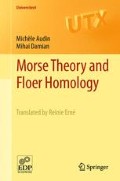Abstract
We define, construct and study pseudo-gradient fields, whose trajectories connect the critical points of a Morse function. These vector fields allow us to define the stable and unstable manifolds of the critical points, which will play an important role. We call attention to the “male property” because of which, for example, there are only finitely many trajectories connecting two critical points with consecutive indices and we prove the existence of pseudo-gradient fields satisfying this property.
Access this chapter
Tax calculation will be finalised at checkout
Purchases are for personal use only
Notes
- 1.
There is also a precise mathematical definition of the expression “perfect Morse function”, of which the one considered here is the prototype.
- 2.
In the cases of the “other sphere” and of the projective plane, this holds, for example, by virtue of Exercise 11 (p. 51).
- 3.
It is a Mores–Bott function (see [14]): its critical points form submanifolds (here P 1(R) for the maximum) and the second-order derivative is transversally nondegenerate.
References
Biran, P.: Lagrangian barriers and symplectic embeddings. Geom. Funct. Anal. 11, 407–464 (2001)
Bott, R.: Lectures on Morse theory, old and new. Bull. Am. Math. Soc. 7, 331–358 (1982)
Lafontaine, J.: Introduction aux Variétés Différentielles. Presses Universitaires de Grenoble, Grenoble (1996)
Latour, F.: Existence de 1-formes fermées non singulières dans une classe de cohomologie de Rham. Publ. Math. IHÉS 80, 135–194 (1994)
Laudenbach, F.: Symplectic geometry and Floer homology, pp. 1–50. Sociedade Brasileira de Matemática (2004)
Milnor, J.: Morse Theory. Princeton University Press, Princeton (1963)
Milnor, J.: Topology from the Differentiable Viewpoint. University Press of Virginia, Charlottesville (1965)
Salamon, D.: Lectures on Floer homology. In: Eliashberg, Y., Traynor, L. (eds.) Symplectic Topology. I.A.S./Park City Math. Series. Am. Math. Soc., Providence (1999)
Smale, S.: On gradient dynamical systems. Ann. Math. 74, 199–206 (1961)
Author information
Authors and Affiliations
Exercises
Exercises
Exercise 10
Show that the vector fields whose flows are drawn in Figure 2.30 are not pseudo-gradient fields.

Fig. 2.30
Exercise 11
Let V be a manifold of dimension 2 endowed with a Morse function with a unique critical point of index 1. Show that every pseudo-gradient field adapted to this function satisfies the Smale condition.
Exercise 12
We fix an integer m≥2. Find all critical points of the function \(f:\mathbf{P}^{1}(\mathbf{C})\mathchoice{\longrightarrow}{\rightarrow}{\rightarrow}{\rightarrow} \mathbf{R}\) defined by
(in homogeneous coordinates or in the affine chart z 1≠0). Verify that for m=2, the function f is not a Morse function.Footnote 3
We suppose that m≥3. Show that f is a Morse function and has two local maxima: the points 0 and ∞; m local minima: the m-th roots of −1; and m critical points of index 1: the m-th roots of 1.
Hint: We can determine the critical points using the derivatives with respect to z and \(\overline {z}\), and then use a second-order Taylor expansion of f(u) with respect to u in the neighborhood of 0 (to study the critical points at 0 and ∞) or the analogous expansion of f(ζ(1+u)) (to study the critical points at ζ with ζ m=±1).
Show that there exists a pseudo-gradient field such as that shown (in an affine chart) in Figure 2.31 (for m=3). More generally, see the article [9] in which an analogous function (defined on P n(C)) plays an important role.

Fig. 2.31
Rights and permissions
Copyright information
© 2014 Springer-Verlag London
About this chapter
Cite this chapter
Audin, M., Damian, M. (2014). Pseudo-Gradients. In: Morse Theory and Floer Homology. Universitext. Springer, London. https://doi.org/10.1007/978-1-4471-5496-9_2
Download citation
DOI: https://doi.org/10.1007/978-1-4471-5496-9_2
Publisher Name: Springer, London
Print ISBN: 978-1-4471-5495-2
Online ISBN: 978-1-4471-5496-9
eBook Packages: Mathematics and StatisticsMathematics and Statistics (R0)

